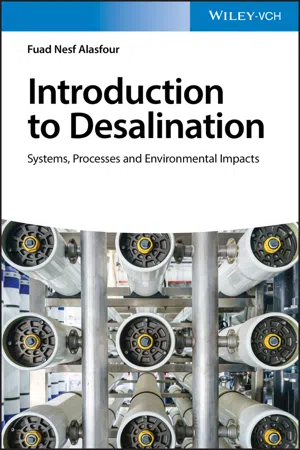
Introduction to Desalination
Systems, Processes and Environmental Impacts
- English
- ePUB (mobile friendly)
- Available on iOS & Android
About This Book
One book dealing with the fundamentals of thermal and membrane desalination systems and discussing their economical as well as environmental aspects. With a growing population, climate change and greater water demand, desalination has increasingly become a part of the solution to regional water scarcity - seawater desalination capacity has roughly doubled in the past ten years. Desalination has also begun to receive more attention in academia, with research focusing on improving energy efficiency and system robustness and lowering capital costs. With this book, an introduction is given to the basics and fundamentals of desalination systems. Both, thermal and membrane desalination systems, are covered and discussed in view of energy, exergy, economic and environmental aspects. In the beginning, Introduction to Desalination: Systems, Processes and Environmental Impacts describes multi effect evaporation, vapor compression and multi-stage flashing. Further chapters deal with common membrane-based separations like reverse osmosis and membrane filtration, forward osmosis, diffusion dialysis and pervaporation as well as thermo-osmosis, electrodialysis and electrodeionization. Subsequently, hybrid systems are discussed, and the economic analysis of such systems and their environmental impact are highlighted. Each chapter contains theoretical and practical examples and concludes with questions and problems for self-study. * Needed: Desalination has become a part of the solution to regional water scarcity and an introductory book in this field is urgently needed. * Balanced Approach: Presents the fundamentals of thermal and membrane desalination systems. * Learning Material: Each chapter includes exercises for self-study and Instructors can find teaching material online. Introduction to Desalination: Systems, Processes and Environmental Impacts is an important resource for master's students in engineering sciences, lecturers in chemical and mechanical engineering, engineers, environmental chemists, as well as process engineers, engineering scientists in industry, and environmental consultants.
Frequently asked questions
Information
1
Introduction
1.1 What Is Desalination?
Table of contents
- Cover
- Table of Contents
- Preface
- 1 Introduction
- Part I: Thermal Desalination Systems
- Part II: Membrane Desalination Systems
- Part III: Nonconventional Desalination Systems
- Appendix A: Appendix AThermo‐Physical Properties of SeawaterThermo‐Physical Properties of Seawater
- Index
- End User License Agreement